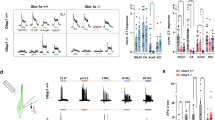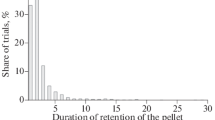Summary
The effects of lingual treatment with amiloride, an inhibitor of salt taste responses in several mammalian species, on NaCl responses of the chorda tympani nerve were compared between four inbred strains of mouse (BALB/cCrSlc, DBA/2CrSlc, C57BL/6CrSlc and C3H/HeSlc). In C57BL and C3H mice amiloride significantly suppressed responses of the chorda tympani nerve to NaCl at a concentration 0.1 M or more whereas in BALB and DBA mice the drug did not significantly affect the responses to NaCl at any concentration, suggesting a lack of the amiloride-sensitive receptor component for NaCl in the latter two strains.
A two-bottle preference test demonstrated that all strains of mouse usually showed no preference for NaCl at any concentration and avoided NaCl at 0.3 M or more, although some differences were observed in that C57BL and C3H mice showed aversive responses to 0.1 and 0.15 M NaCl, whereas BALB and DBA mice were indifferent to these solutions.
The results suggest that there exist prominent differences between mouse strains in the amiloride-sensitive component of their salt receptor systems. However, in mice the taste information derived from the amiloride-sensitive receptor component probably has no remarkable effect on behavioral responses to NaCl except for a possible contribution to decreasing aversion thresholds for NaCl by increasing overall taste information about NaCl.
Similar content being viewed by others
References
Benos DJ (1985) Amiloride: a molecular probe of sodium transport in tissue and cells. Am J Physiol 242:C131-C145
Brand J, Teeter JH, Silver WL (1985) Inhibition by amiloride of chorda tympani responses evoked by monovalent salts. Brain Res 334:207–214
Fregly MJ, Rowland NE (1985) Role of renin-angiotensin-aldosterone system in NaCl appetite of rats. Am J Physiol 248:R1-R11
Fuller JL (1974) Single-locus control of saccharin preference in mice. J Hered 65:33–36
Heck GL, Mierson S, DeSimone JA (1984) Salt taste transduction occurs through an amiloride-sensitive sodium transport pathway. Science 223:403–405
Hellekant G, DuBois GE, Roberts TW, van der Wel H (1988) On the gustatory effect of amiloride in the monkey (Macaca mulatta). Chem Sens 13:89–93
Herness MS (1987) Effect of amiloride on bulk flow and iontophoretic taste stimuli in the hamster. J Comp Physiol A 160:280–288
Hill DL, Bour TC (1985) Addition of functional amiloride-sensitive components to the receptor membrane: a possible mechanism for altered taste responses during development. Dev Brain Res 20:310–313
Hoshishima K, Yokoyama S, Seto K (1962) Taste sensitivity in various strains of mice. Am J Physiol 202:1200–1204
Jakinovich W Jr (1985) Stimulation of the gerbil's gustatory receptors by methyl glycopyranosides. Chem Sens 10:591–604
Klein TW, DeFries JC (1970) Similar polymorphism of taste sensitivity to PTC in mice and men. Nature 227:77–78
Kutscher CL, Steilen H (1973) Increased drinking of a non-preferred NaCl solution during food deprivation in the C3H/HeJ mouse. Physiol Behav 10:29–34
Lush IE (1984) The genetics of tasting in mice. III Quinine. Genet Res Camb 44:151–160
Lush IE (1986) The genetics of tasting in mice. IV The acetates of raffinose, galactose and β-lactose. Genet Res Camb 47:117–123
McPheeters M, Roper SD (1985) Amiloride does not block taste transduction in the mudpuppy, Necturus maculosus. Chem Sens 10:341–352
Nachaman M (1962) Taste preferences for sodium salts by adrenalectomized rats. J Comp Physiol Psychol 55:1124–1129
Ninomiya Y, Tonosaki K, Funakoshi M (1982) Gustatory neural responses in the mouse. Brain Res 244:370–373
Ninomiya Y, Mizukoshi M, Higashi T, Katsukawa H, Funakoshi M (1984a) Gustatory neural responses in three different strains of mice. Brain Res 302:305–314
Ninomiya Y, Higashi T, Katsukawa H, Mizukoshi T, Funakoshi M (1984b) Qualitative discrimination of gustatory stimuli in three different strains of mice. Brain Res 322:83–92
Ninomiya Y, Katsukawa H, Funakoshi M (in press) Alteration of salt taste sensitivity by the neonatal removal of sublingual glands in the rat. Comp Biochem Physiol A
Rice KK, Richter CP (1943) Increased sodium chloride and water intake of normal rats treated with deoxycorticosterone acetate. Endocrinology 33:106–115
Richter CP (1936) Increased salt appetite in adrenalectomized rats. Am J Physiol 115:155–161
Rowland NE, Fregly MJ (1988) Characteristics of thirst and sodium appetite in mice (Mus musculus). Behav Neurosci 102:969–974
Schiffman SS, Lockhead E, Maes FW (1983) Amiloride reduced the taste intensity of Na+ and Li+ and sweeteners. Proc Natl Acad Sci USA 80:6136–6140
Stricker EM, Wilson NE (1970) Salt-seeking behavior in rats following acute sodium deficiency. J Comp Physiol Psychol 72:416–420
Warren RP, Lewis RC (1970) Taste polymorphism in mice involving a bitter sugar derivative. Nature 227:77–78
Will PC, Lebowitz JL, Hopfer U (1980) Induction of amiloride sensitive sodium transport in the rat colon by mineral corticoids. Am J Physiol 238:F261-F268
Wilson CM, Erdos EG, Wilson JD, Taylor BA (1978) Location on chromosome 1 of Rnr, a gene that regulates renin in the submaxillary gland of the mouse. Proc Natl Acad Sci USA 75:5623–5626
Yoshii K, Kiyomoto Y, Kurihara K (1986) Taste receptor mechanism of salts in frog and rat. Comp Biochem Physiol A 85:501–507
Author information
Authors and Affiliations
Rights and permissions
About this article
Cite this article
Ninomiya, Y., Sako, N. & Funakoshi, M. Strain differences in amiloride inhibition of NaCl responses in mice, Mus musculus . J Comp Physiol A 166, 1–5 (1989). https://doi.org/10.1007/BF00190204
Accepted:
Issue Date:
DOI: https://doi.org/10.1007/BF00190204




